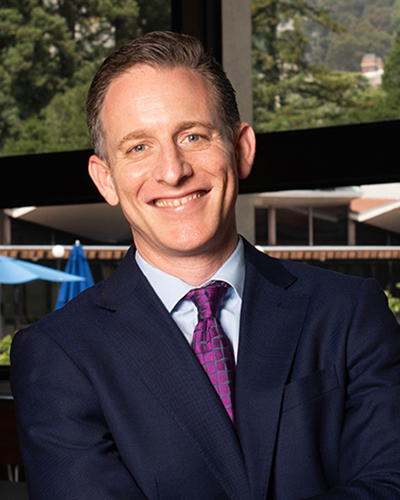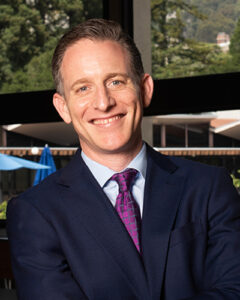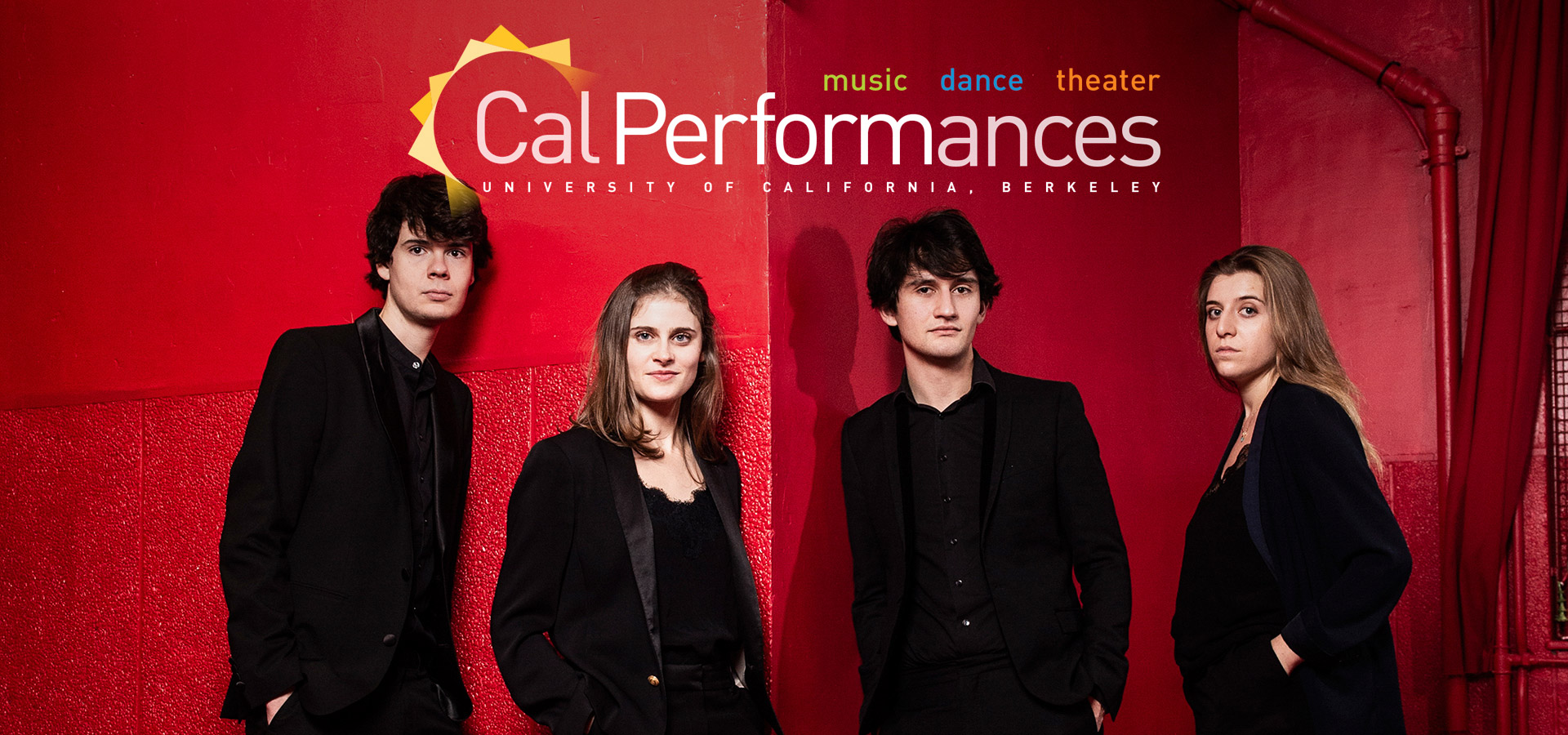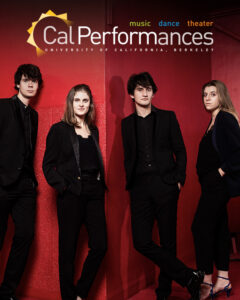Le Consort
Wednesday, November 8, 2023, 7:30pm
First Congregational Church, Berkeley
From the Executive and Artistic Director

November is always a busy month at Cal Performances, and once again this season, I can’t think of a time period that so clearly displays the impressive depth and breadth of our programming. In the coming weeks alone, we’ll run the gamut of live performance, including classical-music recitals with star instrumentalists cellist Sheku Kanneh-Mason (Nov 1) and harpsichordist Jean Rondeau (Nov 5); the brilliant ensemble playing of early-music champions Le Consort (Nov 8) and the Takács Quartet (Nov 12); a return visit by the great San Francisco Symphony, performing under Music Director Esa-Pekka Salonen in a concert featuring the world premiere of a new work by Jens Ibsen and a solo turn by the orchestra’s principal clarinetist Carey Bell (Nov 10); a brilliant new program by the always popular Silkroad Ensemble under artistic director Rhiannon Giddens (Nov 17); our annual visit by The English Concert in an all-star concert performance of Handel’s Rodelina (Nov 19); cutting-edge jazz from the legendary trio of pianist Brad Mehldau (Nov 11); and highly anticipated appearances by theater/cabaret sensations John Cameron Mitchell and Amber Martin (Nov 4) and Broadway superstar Kristin Chenoweth (Nov 15).
And that’s only the start! As we continue through the season, you’ll find more than 80 carefully curated events designed to appeal to the eclectic interests and adventurous sensibilities of Bay Area audiences. In total, this year’s schedule features nearly 30 companies, ensembles, and solo artists new to our program, offering a wide range of opportunities to discover unfamiliar performers and artworks. There’s plenty to enjoy, including six world premieres, six Cal Performances co-commissions, nearly one dozen local and regional premieres, and the West Coast premieres of Taylor Mac & Matt Ray’s Bark of Millions and Nathalie Joachim’s Ki moun ou ye (Who are you?).
Cal Performances continues to invest in ongoing relationships with established and acclaimed artistic partners, with upcoming presentations including a landmark collaboration between Germany’s Pina Bausch Foundation, Senegal’s École des Sables, and the UK’s Sadler’s Wells theater in the first-ever Bay Area performances of Bausch’s pioneering The Rite of Spring (1975), as well as the renewal of a multi-season residency by The Joffrey Ballet, which this year will present its first full-length narrative ballet, Anna Karenina, at Zellerbach Hall. And I’m especially pleased that in March 2024, the renowned pianist Mitsuko Uchida will join us as Artist in Residence for two special concerts as well as additional opportunities for the campus and wider Bay Area community to engage with her singular artistry.
A focus of the season will be our multi-dimensional Illuminations programming, which once again will connect the work of world-class artists to the intellectual life and scholarship at UC Berkeley via performances and public programs investigating a pressing theme—this season, “Individual & Community.” Concepts of “individual” and “community” have been at the forefront of public discourse in recent years, with some models increasing polarization and radicalization within our society. Questions have emerged as to how we can best nurture a sense of community and how the groups we associate with impact our own sense of self. Given our fast-evolving social landscape, how can we retain and celebrate the traits that make each of us unique, while still thriving in a world that demands cooperation and collaboration? With the performing arts serving as our guide and compass, our 2023–24 “Individual & Community” programming will explore the tensions that come into play when balancing the interests of the individual with those of the group.
Please make sure to check out our website for complete information. We’re thrilled to share all the details with you, and to welcome you once again to Cal Performances!
Jeremy Geffen
Executive and Artistic Director, Cal Performances
 November is always a busy month at Cal Performances, and once again this season, I can’t think of a time period that so clearly displays the impressive depth and breadth of our programming. In the coming weeks alone, we’ll run the gamut of live performance, including classical-music recitals with star instrumentalists cellist Sheku Kanneh-Mason (Nov 1) and harpsichordist Jean Rondeau (Nov 5); the brilliant ensemble playing of early-music champions Le Consort (Nov 8) and the Takács Quartet (Nov 12); a return visit by the great San Francisco Symphony, performing under Music Director Esa-Pekka Salonen in a concert featuring the world premiere of a new work by Jens Ibsen and a solo turn by the orchestra’s principal clarinetist Carey Bell (Nov 10); a brilliant new program by the always popular Silkroad Ensemble under artistic director Rhiannon Giddens (Nov 17); our annual visit by The English Concert in an all-star concert performance of Handel’s Rodelina (Nov 19); cutting-edge jazz from the legendary trio of pianist Brad Mehldau (Nov 11); and highly anticipated appearances by theater/cabaret sensations John Cameron Mitchell and Amber Martin (Nov 4) and Broadway superstar Kristin Chenoweth (Nov 15).
November is always a busy month at Cal Performances, and once again this season, I can’t think of a time period that so clearly displays the impressive depth and breadth of our programming. In the coming weeks alone, we’ll run the gamut of live performance, including classical-music recitals with star instrumentalists cellist Sheku Kanneh-Mason (Nov 1) and harpsichordist Jean Rondeau (Nov 5); the brilliant ensemble playing of early-music champions Le Consort (Nov 8) and the Takács Quartet (Nov 12); a return visit by the great San Francisco Symphony, performing under Music Director Esa-Pekka Salonen in a concert featuring the world premiere of a new work by Jens Ibsen and a solo turn by the orchestra’s principal clarinetist Carey Bell (Nov 10); a brilliant new program by the always popular Silkroad Ensemble under artistic director Rhiannon Giddens (Nov 17); our annual visit by The English Concert in an all-star concert performance of Handel’s Rodelina (Nov 19); cutting-edge jazz from the legendary trio of pianist Brad Mehldau (Nov 11); and highly anticipated appearances by theater/cabaret sensations John Cameron Mitchell and Amber Martin (Nov 4) and Broadway superstar Kristin Chenoweth (Nov 15).
And that’s only the start! As we continue through the season, you’ll find more than 80 carefully curated events designed to appeal to the eclectic interests and adventurous sensibilities of Bay Area audiences. In total, this year’s schedule features nearly 30 companies, ensembles, and solo artists new to our program, offering a wide range of opportunities to discover unfamiliar performers and artworks. There’s plenty to enjoy, including six world premieres, six Cal Performances co-commissions, nearly one dozen local and regional premieres, and the West Coast premieres of Taylor Mac & Matt Ray’s Bark of Millions and Nathalie Joachim’s Ki moun ou ye (Who are you?).
Cal Performances continues to invest in ongoing relationships with established and acclaimed artistic partners, with upcoming presentations including a landmark collaboration between Germany’s Pina Bausch Foundation, Senegal’s École des Sables, and the UK’s Sadler’s Wells theater in the first-ever Bay Area performances of Bausch’s pioneering The Rite of Spring (1975), as well as the renewal of a multi-season residency by The Joffrey Ballet, which this year will present its first full-length narrative ballet, Anna Karenina, at Zellerbach Hall. And I’m especially pleased that in March 2024, the renowned pianist Mitsuko Uchida will join us as Artist in Residence for two special concerts as well as additional opportunities for the campus and wider Bay Area community to engage with her singular artistry.
A focus of the season will be our multi-dimensional Illuminations programming, which once again will connect the work of world-class artists to the intellectual life and scholarship at UC Berkeley via performances and public programs investigating a pressing theme—this season, “Individual & Community.” Concepts of “individual” and “community” have been at the forefront of public discourse in recent years, with some models increasing polarization and radicalization within our society. Questions have emerged as to how we can best nurture a sense of community and how the groups we associate with impact our own sense of self. Given our fast-evolving social landscape, how can we retain and celebrate the traits that make each of us unique, while still thriving in a world that demands cooperation and collaboration? With the performing arts serving as our guide and compass, our 2023–24 “Individual & Community” programming will explore the tensions that come into play when balancing the interests of the individual with those of the group.
Please make sure to check out our website for complete information. We’re thrilled to share all the details with you, and to welcome you once again to Cal Performances!
Jeremy Geffen
Executive and Artistic Director, Cal Performances
About the Program
A Journey Through Baroque Europe
At the beginning of the 18th century, the city of Venice was home to a remarkable number violinists and genius composers. Antonio Vivaldi’s talents are beyond question: he has achieved lasting fame as one of the most inventive, prolific, and virtuosic composers of the Baroque period. The Trio Sonata in G minor, Op. 1, No. 1 is the very work first Vivaldi published, when he was 23 years old. Its five sections mingle elements of the sonata da chiesa (Preludio Grave and Adagio) with dances (Allemanda, Capriccio, Gavotta). Vivaldi first plunges us into the intensely contemplative atmosphere of a Venetian church, then surprises us with dance movements in which the violins vie with each other in terms of virtuosity.
As for the violinist-composer Giovanni Battista Reali, his life is shrouded in mystery. He published only two opus numbers: a set of 12 trio sonatas in 1709, followed in 1712 by solo sonatas for violin and bass continuo. That his trio sonatas were republished in Amsterdam by Estienne Roger in 1710 is proof that his works enjoyed a degree of success, but we know very little of his biography. He is mentioned as being a violinist in Venice’s Teatro San Fantin, then in 1727 as maestro di cappella for the Duke of Guastalla in Emilia-Romagna—after which we lose all trace of him. This Grave is an intimate duet of two violins.
The trio sonata was born during the second half of the 17th century and it was Arcangelo Corelli, the master of the genre, who developed, established, and popularized it throughout Europe. A violin virtuoso himself, he devoted his entire output to that instrument. Of the six sets of compositions he left behind, the first four are devoted to the trio with two violins, which became the paramount ensemble of the Baroque era. The immensely famed Corelli became a model for his contemporaries, having a strong influence on the composers of his own time and on succeeding generations as well. Publication of his works was keenly anticipated throughout the whole of Europe, each new opus enjoying a success even greater than the last. The Trio Sonata in
C major, Op. 4, No. 1 is luminous, with a breathtaking third movement.
“Les Sauvages” is undoubtedly Jean-Philippe Rameau’s most famous piece. Originally for harpsichord, it was reorchestrated and inserted into the new “entrée” added in 1736 in his celebrated opera Les Indes Galantes. Rameau’s source of inspiration was the presentation, in 1725, at the Théâtre des Italiens, of natives from Louisiana dancing to the sounds of their instruments. Influenced by the exoticism of this encounter, he translated into music this obsessive rhythmic repetition.
The trio sonatas of Jean-François Dandrieu really do deserve a place in the very front rank of the chamber music of the period. They show a mastery of style as well as a variety of astonishing character types. There are dances overflowing with energy; a playful, spirited counterpoint between the three voices; movements that seem suspended in time by the most expressive italianate ritardandi, with articulation, phrasing, rhythm, sweetness, and passion.
So who was Dandrieu? Born in 1682, in the heart of Paris, on the l’Île de la Cité, Jean-François grew up in the family home. From his earliest years he devoted himself to music: even as a young boy he was able to play the harpsichord with tremendous facility. In 1687, aged only five, he presented himself at the court of Versailles before the Princess of the Palatinate, to whom he later dedicated his trio sonatas. On reaching adulthood, Dandrieu decided to consecrate himself to God, taking holy orders.
Dandrieu’s Op. 1 sonatas carry special meaning for us, as they were the very first works we read during our initial rehearsals. Perhaps we felt a special connection since he was about our ages—23—when he published them. Whatever the reasons, we felt a common bond with his Trio Sonata in G minor, Op. 1, No. 3. From our very first rehearsals together, we discovered the darting motifs of those descending appoggiaturas and there was, quite simply, a feeling we all shared: a common rhythm. The ensuing rapid, light-footed Allegro is marked by a fugue that is completely Italian in character. The third movement, meditative, quasi-liturgical, is a contemplation in an introspective lyrical form, without a trace of ostentation. The final gigue brings us back to the French style, with its bass voice recalling the full, earthy style of Forqueray. For all of us, it was the moment of falling in love, both musically and emotionally. This sonata has become our anthem, our watchword, an emblematic banner of our vision of the trio sonata.
The Violin Sonata in D minor, Op. 5, No. 12 by Corelli is a set of virtuosic variations on the popular ground bass in triple time known by its Spanish name La Folia— alluding to the “frenzy” of the dance—and is unquestionably among the composer’s most popular works.
Francesco Maria Veracini, was born in Florence and enjoyed a tremendous life travelling across Europe. This final movement from the Violin Sonata in A major, Op. 1, No. 7, written in the high register of the Baroque violin, is quite challenging to perform. (Incidentally Veracini played on a violin made by Jakobus Stainer, the maker of Théotime’s instrument)
The Mad Lover began life around 1616 as a comedy by the prolific and versatile English dramatist John Fletcher, a younger contemporary of William Shakespeare (with whom he collaborated on two plays). The score from Eccles for a new version of Fletcher’s play, besides its three masques, included an abundance of instrumental pieces, such as this ground. The descending tetrachord forms a relentless, repetitive motif, one that sticks in the memory with an immediacy that touches all who hear it.
The greatest musical genius of late 17th century London was undoubtedly Henry Purcell, an extraordinary musician present on all fronts. At a time when both the form and the instrument already belonged to a fast-disappearing world, he wrote the last fantasias for viols in the great English tradition. He was also enthusiastic about the newer violin and the Italian sonata. Purcell had his Sonatas of III Parts printed at his own expense in 1683, a significant risk for the youthful composer, still only 24 years old. And sadly, these works remained misunderstood: the 1683 collection, along with a successor of 1697 (from which these piece is taken) published by his widow after his death, sold so poorly that Frances Purcell was forced to remainder them, without being able to sell off her stock. Purcell, so beloved for his operas, had bad luck with his sonatas. Yet from the very beginnings of our work as an ensemble, we have performed the wonderful Sonata of Four Parts No. 6 in G minor, Z. 807. Built on a ground that repeats itself tirelessly, this work is a compendium of Purcell’s genius that examines the human soul in its most intimate aspects, and through its emotional intensity remind us of Dido’s Lament by the same composer.
In the Gavotte et ses Doubles, the term “double,” derived from the French air of the 17th century, denotes the variety of reprise of a piece. Here, Rameau has a “orchestral” bent, his variations are based on rhythm, harmony, melodic variation, and the interplay between registers.
Bach’s trio Sonata BWV 1038 is enigmatic. While the surviving materiel is in Bach’s handwriting, the source is unsigned and its authenticity regularly questioned. In four movements, this sonata in G major is inspired by the Italian style. This influence is even more visible in the Andante BWV 974, adapted from a work originally by the venetian composer Marcello for oboe and orchestra. Bach discovered the score and decided to transcribe it for his own instrument, the harpsichord.
Vivaldi’s Trio Sonata in D minor, Op. 1, No. 12, La Follia, is a masterpiece of the trio sonata repertoire, irresistible in its sheer momentum. The variations are built up impressively: by turns slow and fast, introspective and passionately fiery, they unfold organically with stylistic mastery, taking performers and listeners alike on a journey from intimacy to virtuosity.
—© 2023 Sophie de Bardonnèche



